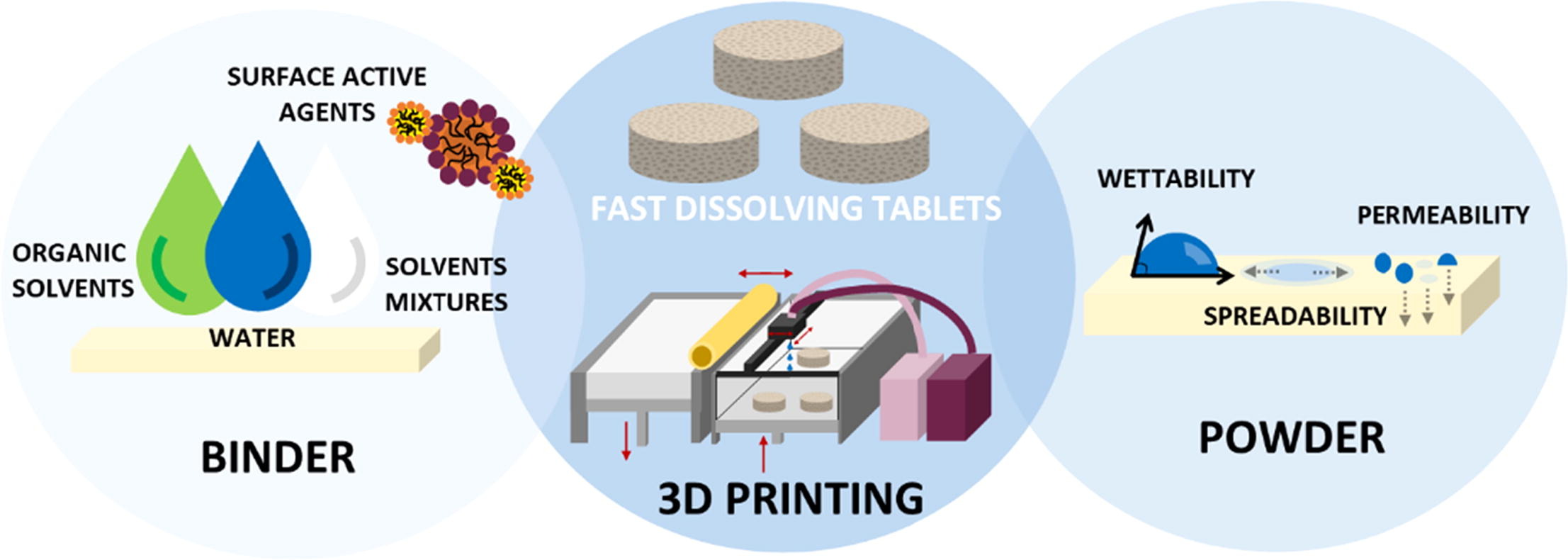Binder jetting 3D printing of challenging medicines: from low dose tablets to hydrophobic molecules

Increasing access to additive manufacturing technologies utilising easily available desktop devices opened novel ways for formulation of personalized medicines. It is, however, challenging to propose a flexible and robust formulation platform which can be used for fabrication of tailored solid dosage forms composed of APIs with different properties (e.g., hydrophobicity) without extensive optimization.
This manuscript presents a strategy for formulation of fast dissolving tablets using binder jetting (BJ) technology. The approach is demonstrated using two model APIs: hydrophilic quinapril hydrochloride (QHCl, logP = 1.4) and hydrophobic clotrimazole (CLO, logP = 5.4). The proposed printing method uses inexpensive well known and easily available FDA approved pharmaceutical excipients.
The obtained model tablets had uniform content of the drug, excellent mechanical properties and highly porous structure resulting in short disintegration time and fast dissolution rate. The tablets could be scaled and obtained in predesigned shapes and sizes. The proposed method may find its application in the early stages of drug development where high flexibility of the formulation is required and the amount of available API is limited.
Download the full article as a PDF here or read it here
Materials: Quinapril hydrochloride, clotrimazole and lactose monohydrate were donated by P.P.F. “Hasco-Lek” (Wroclaw, Poland). Paracetamol, ibuprofen, naproxen, and famotidine were donated from US Pharmacia Sp. z o.o. (Wroclaw, Poland). Microcrystalline cellulose and polyvinylpyrrolidone-25 (PVP) were donated by Pharmaceutical Research Institute (Warsaw, Poland). Tween 20, ethyl cellulose and flufenamic acid were purchased from Sigma Aldrich (Saint-Luis, MA, USA). Sodium Dodecyl Sulphate (SLS), methylcellulose, hydroxypropyl methylcellulose (HPMC, 4000 and 100000 cps), were purchased from P.P.H. „STANLAB” Sp.J. (Lublin, Poland). Acetonitrile, isopropanol, dichloromethane and HPLC quality water were purchased from T.J. Baker (Deventer, Netherlands). Concentrates of phosphate (pH = 6,8) and acetate (pH = 4.0) buffers as well as 0.1 M hydrochloric acid concentrate for dissolution were purchased from Chemlab Sp. z o.o. (Kielce, Poland). Acetonitrile and methanol for HPLC was purchased from Merck (Darmstadt, Germany).
Article information: Marta Kozakiewicz, Karol P. Nartowski, Aleksandra Dominik, Katarzyna Malec, Anna M. Gołkowska, Adrianna Złocińska, Małgorzata Rusińska, Patrycja Szymczyk-Ziółkowska, Grzegorz Ziółkowski, Agata Górniak, Bożena Karolewicz, Binder jetting 3D printing of challenging medicines: from low dose tablets to hydrophobic molecules, European Journal of Pharmaceutics and Biopharmaceutics, 2021. https://doi.org/10.1016/j.ejpb.2021.11.001.

